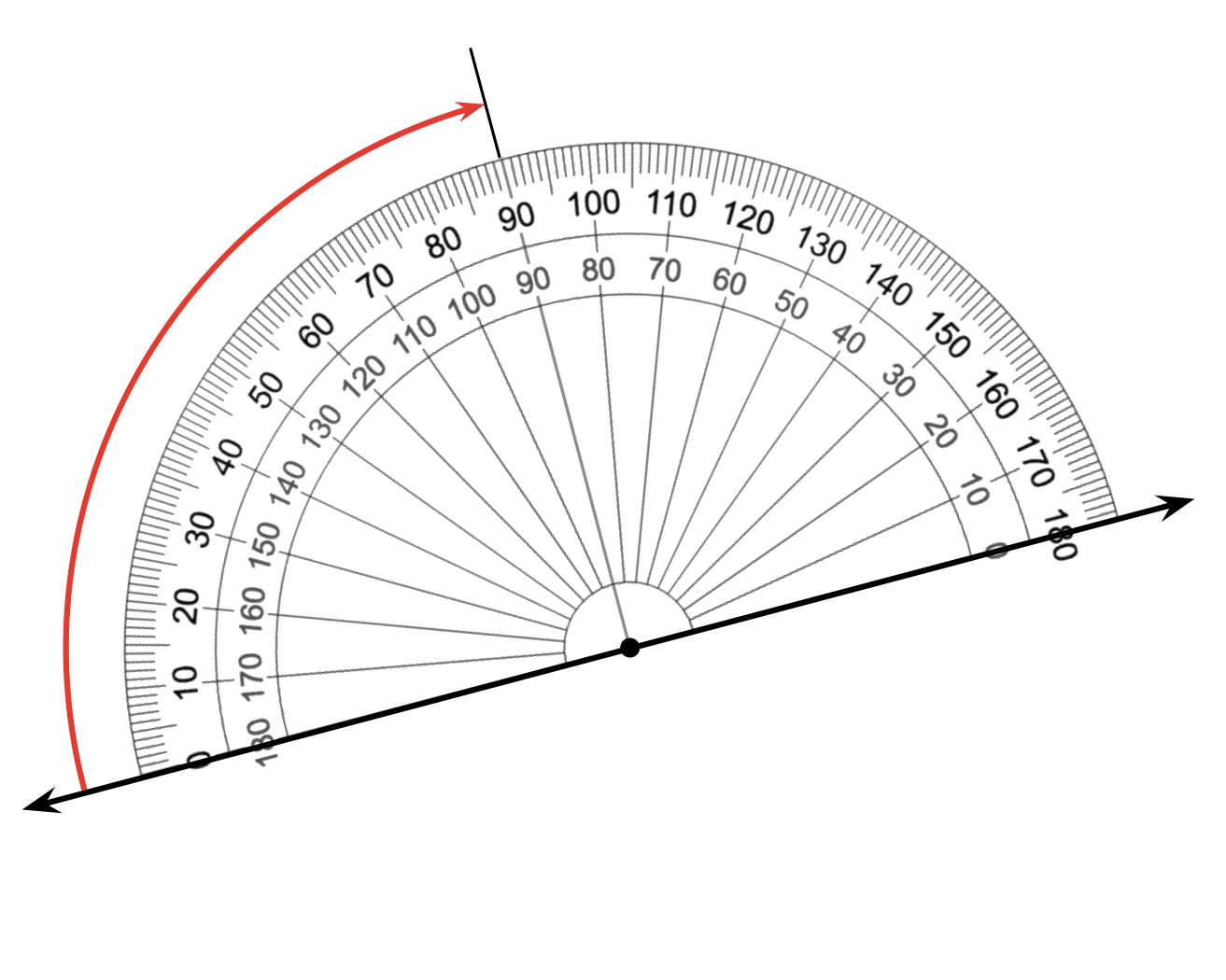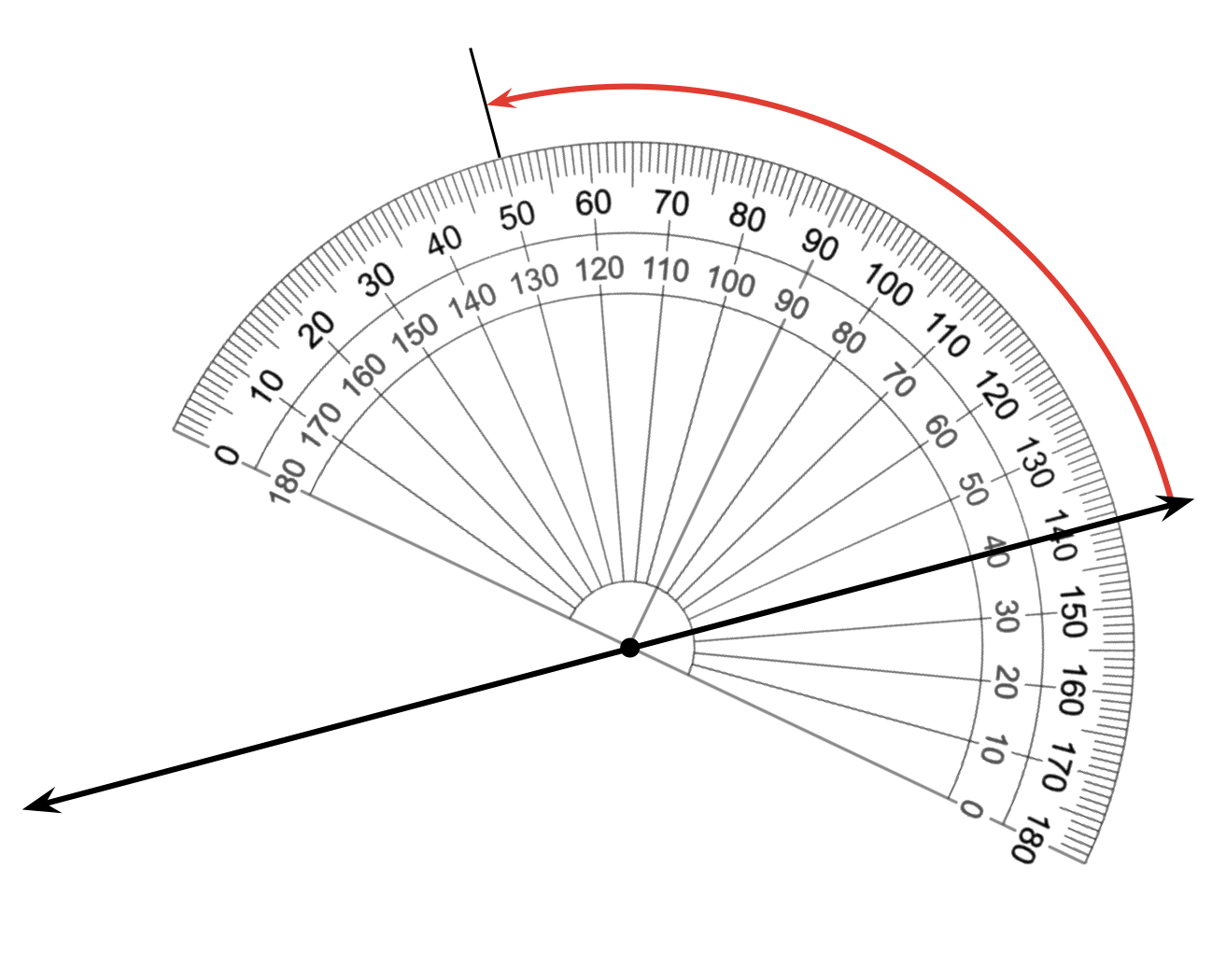Lesson 11
Use a Protractor to Draw Angles
Warm-up: Estimation Exploration: Long Hand and Short Hand (10 minutes)
Narrative
In this warm-up, students practice estimating a reasonable angle measurement based on their knowledge of angles so far and their familiarity with clocks. Later in the unit, students will take a closer look at the angles in an analog clock and apply their understanding of angles to solve more sophisticated problems.
Launch
- Groups of 2
- Display the image.
- “What is an estimate that’s too high? Too low? About right?”
- 1 minute: quiet think time
Activity
- 1 minute: partner discussion
- Record responses.
- Draw an arc to show the clockwise turn of the minute hand from the hour hand (label the \(143^\circ\)measurement with an arc).
- “Your estimate should show the size of this angle in degrees. If you need to, revise your estimates.”
- As needed, record any revisions.
Student Facing
How many degrees is the angle formed by the long hand and the short hand of the clock?

Make an estimate that is:
| too low | about right | too high |
|---|---|---|
| \(\phantom{\hspace{2.5cm} \\ \hspace{2.5cm}}\) | \(\phantom{\hspace{2.5cm} \\ \hspace{2.5cm}}\) | \(\phantom{\hspace{2.5cm} \\ \hspace{2.5cm}}\) |
Student Response
For access, consult one of our IM Certified Partners.
Activity Synthesis
- Consider asking:
- “Is anyone’s estimate less than _____? Is anyone’s estimate greater than _____?”
- “How did you go about making an estimate? How did you know that _____ must be too low and _____ must be too high?”
- “Based on this discussion does anyone want to revise their estimate?”
- Consider revealing the actual measurement: \(143^\circ\).
Activity 1: Draw These Angles (15 minutes)
Narrative
In this activity, students follow directions for drawing lines, rays, and angles. To create angles precisely and as specified, students need to use a protractor and a ruler or straightedge (MP6).
Each step in the drawing process involves one or more decisions for students to make. In some cases, the resulting drawing will be the same.
For example, in the first question, students could use the protractors in different ways to create perpendicular lines.
Going from \(0^\circ\) to \(90^\circ\)
(outer set of numbers):
Going from \(20^\circ\) to \(110^\circ\)
(outer set of numbers):


Going from \(40^\circ\) to \(130^\circ\)
(inner set of numbers):

In other cases, the resulting drawings will vary depending on the decisions made. For example, in the second question, students could choose to draw the first angle (\(40^\circ\)) above or below the given ray. When drawing the second angle (\(20^\circ\)), they could choose to draw it inside the \(40^\circ\) angle or adjacent to the \(40^\circ\) angle (and choosing one side or the other)—in both cases meeting the specifications. The answer to the last question will thus also vary.
Advances: Speaking
Supports accessibility for: Visual-Spatial Processing, Language, Fine Motor Skills
Required Materials
Materials to Gather
Launch
- Groups of 2
- Give each student a protractor and access to rulers or straightedges.
- 2 minutes: independent work time on the first question
- Pause for class discussion. Ask 1–2 students to share how they drew their perpendicular lines.
Activity
- 5–6 minutes: independent work time on the remaining questions
- 2 minutes: partner discussion
- Identify students with different-looking drawings to share later.
Student Facing
- Draw a line that is neither vertical nor horizontal. Put a point somewhere on that line. Use your protractor to draw a perpendicular line through that point. Be as precise as possible. (No folding this time!)
-
Here is a ray that starts at point \(M\).
Use a protractor to draw:
- A ray starting at point \(M\) to create a \(40^\circ\) angle.
- Another ray starting at point \(M\) to create a \(20^\circ\) angle.
- One more ray starting at point \(M\) to create a \(95^\circ\) angle. Label each angle with its measurement.
- In your drawing, there should be one angle that is not labeled with a measurement and is larger than \(180^\circ\) . Label the angle with an arc. How many degrees is this angle? Be prepared to explain how you know.
Student Response
For access, consult one of our IM Certified Partners.
Activity Synthesis
- Select students to share their drawings and their reasoning for the last question.
- “What decisions did you have to make when creating the drawing?”
- “Many of you placed the \(20^\circ\) angle next to the \(40^\circ\) angle. Some of you placed them inside the \(40^\circ\) angle. How did the different choices affect the size of the angle in the last question?” (Putting the \(20^\circ\) inside the \(40^\circ\) angle made the last angle \(20^\circ\) larger.)
Activity 2: Angles Made to Order (20 minutes)
Narrative
In the first activity, students drew angles with some scaffolding in place: a line and a point were given, each step was described, and the vertex and measurements of each angle were specified.
In this activity, students continue to draw angles but with less guidance. For each drawing, students are given only a range of angle measurements and no other criteria, prompting them to make additional decisions about how to draw the angles (for instance, where the vertex of an angle should be, how the first ray or line should be oriented, and so on). After drawing, students trade their cards and use a protractor to measure and check one another’s angles.
The drawings created here will be used in the next lesson. Consider collecting the cards from each group or otherwise supporting students in keeping the cards until then.
Required Materials
Materials to Gather
Launch
- Groups of 2
- Give each student one protractor and 4 blank (unlined) index cards.
- Give students access to rulers or straightedges.
Activity
- 7–8 minutes: independent work time on the first question, then switch cards and complete the second set of questions
Student Facing
Your teacher will give you some blank cards. Label them a–d.
-
On each card, draw an angle that meets one requirement. Use a ruler and a protractor.
- an angle that is less than \(35^\circ\)
- an angle that is between \(35^\circ\) and \(80^\circ\)
- an angle that is greater than \(80^\circ\) but less than \(120^\circ\)
- an angle that is greater than \(120^\circ\) but less than \(180^\circ\)
-
Trade cards with your partner.
- Measure and record each angle your partner drew. Check to make sure each angle meets the requirement.
- If a requirement is not met, return it to your partner so it can be corrected. Save the cards for the next lesson.
If you have time:
- Create a drawing that shows several angles. Then, write some descriptions of your drawing. Be as specific as possible.
- Ask a partner to recreate the drawing based on your descriptions. Does their drawing turn out as you had drawn? If not, adjust your descriptions and ask them to try again.
Student Response
For access, consult one of our IM Certified Partners.
Activity Synthesis
- Invite students to share 1–2 examples of an angle that meets each requirement.
- Consider asking:
- “Can you tell just by looking that this angle is _____?”
- “If you say yes, explain.”
- “If you say no, what would you need to make sure it is _____?”
Lesson Synthesis
Lesson Synthesis
“Today we used protractors to draw angles of different sizes and to check one another’s drawings.”
“What were some challenges in drawing angles precisely?” (Some possible challenges:
- The distance between the closest tick marks, showing \(1^\circ\) angles, is very small. It’s easy to misread the marks.
- If the first ray is not lined up correctly at \(0^\circ\) or \(180^\circ\), or if the vertex is not lined up exactly at the center point of the protractor, then the created angle would be off.)
“In the last activity, you drew a bunch of angles, some smaller, some larger. Did you find some sizes of angles easier to draw than others? Why or why not?”
“If we were explaining to a classmate how to use a protractor to measure angles, what should we say?”
Cool-down: A Ray or Two (5 minutes)
Cool-Down
For access, consult one of our IM Certified Partners.
Student Section Summary
Student Facing
In this section, we learned about ways to describe and measure the size of angles.
We used clocks to describe angles as a turn of one away from the other. We learned that a degree is a measure of the turn around a circle and that 1 degree is \(\frac{1}{360}\) of a full turn of a ray through a circle.
Finally, we learned that a protractor is a tool used to measure angles and can also be used to create angles of a certain measure.

A protractor has two sets of numbers and that either set of numbers could be used, but it is helpful to use the set that counts up from 0 rather than count down from 180. We used a protractor to measure and draw different angles.
